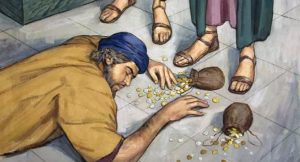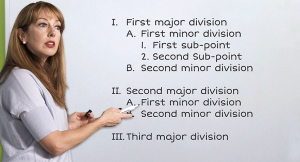In my last post, I wrote about what Luke, the author of Acts, meant when he wrote that “all things were common property” (Acts 4:32) in the early church. I then took a look at Ananias and Sapphira. Finally, I discussed the Greek middle voice as it pertains to the expression “kept back” (Acts 5:2) or “keep back” (verse 3).
In addition, I indicated that for this post, we would determine how it is that Ananias and Sapphira were stealing from God. First, however, we need to answer a question asked in the post launching this study. For that reason, we won’t address the sin of Ananias and Sapphira yet.
[NOTE: As I began to tackle the question about Ananias and Sapphira, I came to realize that it is not as simple as I had assumed. For that reason, this post will not be the final one. I will not be addressing how Ananias and Sapphira could be stealing from God until a fourth post.]
Land Ownership in the Early Church
To answer the question, “What land and what houses?” that I asked in my introductory post, I decided to check a number of resources, including The New Testament Era, by Bo Reicke; The New Manners and Customs of Bible Times, by Ralph Gower; and the five-volume History of the Jewish People in the Time of Christ, by Emil Schurer. These are all great resources, but not a single one discusses land ownership in the early church.
Next I looked up the word land in the digital Encyclopedia of the Bible, but to no avail. All I found were entries for “Land Crocodile” and “Landmark,” but nothing on land itself!
At this point, after so many dead ends, I went to the internet. Once again, I found a distinct void of material discussing land and property ownership in New Testament times. I did find one article addressing the economic situation of widows in the New Testament world. It examines property ownership under Roman law, Egyptian law, and law in Asia Minor.
When I reached a paragraph about Jewish widows, I thought I was going to find my answer. Unfortunately, I was once again frustrated. The author, Susan E. Hylen, a professor of New Testament at Emory University in Atlanta, wrote:
It can be difficult to understand the specific situation of Jewish women in the New Testament period because direct evidence is sparse. However, the evidence that exists suggests that their lives were similar to those of non-Jewish women.
Trying Another Path
I turned to my physical copy of The Zondervan Pictorial Encyclopedia of the Bible. That’s because on occasion it has some entries not retained for the digital version. I did find something. Before I could even get excited about discovering the entry for “Land Laws,” though, I saw that it contains nothing about land laws affecting the early church. All it had was a referral to another entry, “Law in the OT.”
Even so, I thought it couldn’t hurt to look over Old Testament laws on the subject. When I checked, I saw that the digital version of the encyclopedia has this entry as well. In it I found a statement that seems to support the idea that Old Testament property laws were still in effect at the time of Herod.
The statement is in the first paragraph under section 6. Land laws in the OT. This section explains that the Mishnah “seems to preserve additional laws in force at the time of the destruction of Herod’s Temple.” The fact that these are additional laws suggests that the Old Testament laws were still in effect at the time of the early church. With that assumption – and that’s what it is – I’ll continue by looking at some basic Old Testament land laws.
Old Testament Real Estate 101
Anyone who has read through the Old Testament should recognize the importance of land to the ancient Israelites. Their destination as they left Egypt was the Promised Land! God had specifically promised Abraham that his descendants would someday own the land of Canaan (Genesis 24:7). Centuries later Moses referred to that promise in his intercessory prayer on behalf of a rebellious Israel (Deuteronomy 9:28).
Throughout Israel’s history, the land was an integral component of their covenant relationship with God. His people always understood that ultimately, the land belonged to God. Under Joshua, the 12 tribes took possession of the land. Where each tribe, and each clan and each family within the tribe, ended up, however, was determined by lot (Joshua 14:1-5). Even though it was the priests who cast the lots, it was God who decided where the tribes would settle.
Just before Moses died, the daughters of Zelophehad approached him with a question about inheriting land (Numbers 27:1-4). Their father had died without male heirs. They wanted to know what was to be done with the portion of land he would have received in the Promised Land. Moses went to God for an answer (verse 5). God spelled out the priority of claims for inheriting the land. The heir was always to be someone in the family. Significantly, no one ever had the right to pass the land on to someone outside the family (verses 6-11).
How About Selling the Land?
Israelite land laws in the Old Testament permitted the sale of land, but such sales were closer in nature to what would be called long-term leases today. That’s because no individual ever retained absolute ownership of the land. God tells His people that He owns the land, and that it “shall not be sold permanently” (Leviticus 25:23). Land was to remain within the family – period!
An individual who did not want to till the land, or to plant an orchard or vineyard, could sell to someone outside the family. Similarly, anyone who had fallen on hard times, and who needed money, could also sell. But in either case the land would automatically revert to the family during the Jubilee Year, as Moses described (Leviticus 25:8-17). This special year occurred once every 50 years.
There was one more limitation on the sale. At any time after selling his land, the original owner could buy it back, or a close relative could redeem the property on his behalf. In such cases, the person who had purchased the land was obligated to sell it back, and at a fair price – reflecting the number of years remaining until the Jubilee (Leviticus 25:25-28).
Houses, Levites, and the Right of Redemption
There are a few exceptions to these rules (Leviticus 25:29-31). The right of redemption as it pertains to houses varies somewhat from redemption rights for agricultural fields, probably because the fields were a family’s means of supporting itself. Houses in walled cities carried only a one-year right of redemption, and ownership of such a house could pass permanently out of a family. This exception did not apply to houses in open fields, or in villages without walls, because these houses were in close proximity to the fields the family worked.
Another important distinction applied to the Levites. (This was one of the terms I mentioned in my post laying out our plan of attack for this study because Joseph, called Barnabas, was a Levite.) The exception for Levites points directly to their identity among the people of Israel.
These Israelites retained a permanent right of redemption for their houses within walled cities (Leviticus 25:32-33), and they were prohibited from selling the pasture fields of their cities (verse 34). In both cases, the law refers to these houses and these fields as their inheritance among Israel.
Who Were the Levites, Anyway?
The Levites were members of the tribe of Levi, specially selected for service connected to the Tabernacle, and later, the Temple (Numbers 3:5-7). Easton’s Bible Dictionary entry on “Levites” explains that, “When the Israelites left Egypt, the ancient manner of worship was still observed by them, the eldest son of each house inheriting the priest’s office. At Sinai the first change in this ancient practice was made.”
God specifically tells Moses that He has chosen the Levites “instead of every firstborn” (Numbers 3:11-13). It’s interesting that the Israelites initially kept the Passover in intimate family settings (Exodus 12). Family members presided over the first Passover when the death of Egypt’s firstborn was occurring.
As God’s chosen firstborn, the tribe of Levi did not inherit a tribal allotment (Deuteronomy 10:9). Individual Levitical families did not have tracts of farmland, orchards, or vineyards. They did, however, own pasture land around the cities in which they lived (Numbers 35:2-5).
My Upcoming Post
Hopefully we’ll be able to wrap up this study in the next post. When we do, we’ll briefly consider the reason Luke mentioned Barnabas in this story about Ananias and Sapphira. Finally, we’ll determine why Ananias and Sapphira had to die.
In the meantime, I’d like to hear your thoughts. Have you found any answers about New Testament land laws? Have you discovered any other background information that might shed light on the behavior of the early church?




